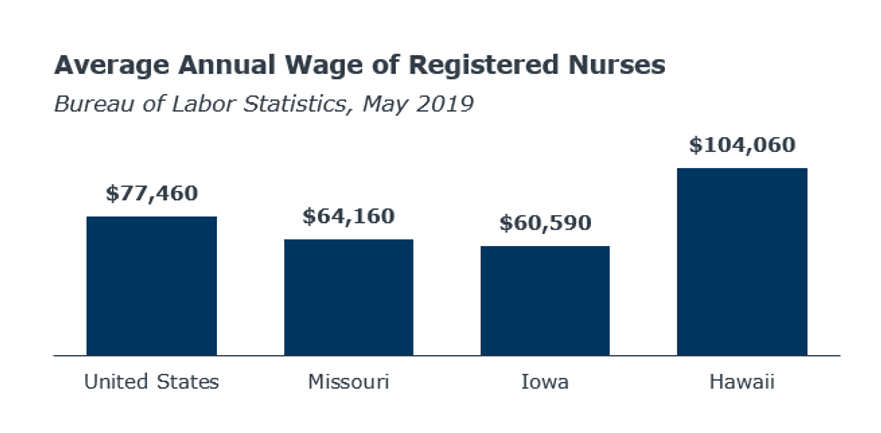2 strategies to grow enrollments in your nursing programs (during and after COVID-19)
July 14, 2020, By Lauren Edmonds, Senior Director, Research Development
Co-authored by Jessica Finn
As a researcher focused on labor market trends—and how they relate to enrollment in graduate, online, professional, and adult education programs—I spend a lot of my workday helping institutions think through how employer demand impacts the viability of new or existing academic programs. One of the most frequent requests we receive from our Professional and Adult Education Forum partners is for research on nursing programs. And more specifically, why does strong employer demand for nurses not always translate to strong enrollments in nursing programs?
The COVID-19 pandemic has led us to take an even closer look at the challenges facing nursing programs and how academic and enrollment leaders can optimize programs and recruitment strategy to attract nursing students. But even before the pandemic, the US had been experiencing a significant shortage of nursing professionals. An aging baby boomer generation, coupled with insufficient nursing program enrollment growth, has left an already understaffed industry facing critical shortages. And despite growing employer demand for nurses, degree conferrals nationwide have not kept pace. States such as Hawaii, Iowa, and Missouri even reported declining nursing degree conferrals between the 2013-2014 and 2017-2018 academic years.

3 factors limiting enrollment in nursing programs
Low wages
Our research has consistently shown that career advancement and increased earning potential are some of the top reasons adult learners choose to pursue enrollment. But traditionally low wages for nurses in many states may limit student interest in pursuing nursing. Legislation such as Iowa House File 291 has further eroded nurse pay, excluding nurses from qualifying for overtime.
But low wages don’t completely explain the enrollment challenges nursing programs face. Even in states where nurses earn more, such as Hawaii, higher wages have been insufficient in bridging the gap between the need for nurses and a lack of qualified graduates.

Burnout
It’s no secret that nursing is hard work, but increasingly burnout is threatening an already shrinking labor pool. Nurses cite burnout and staffing shortages as reasons for leaving the profession, feeling unable to care safely for patients in already understaffed facilities. Burnout not only causes nurses to leave the profession—exacerbating the gap between nursing degree conferrals and employer demand for nurses—but it may also limit the number of students interested in pursuing a nursing career.
“You show up, and you’re already going to be on a unit that’s understaffed. There was just this anxiety you start to develop because you’re afraid for the other shoe to drop … you’re overstretched and you feel like you’re not able to provide the sort of care that you know you need to.”
– Former nurse Amanda Sommer, in an interview with St. Louis Public Radio
Faculty shortages
Nursing programs must also contend with persistent faculty shortages. Many schools have been forced to reduce their program size, as state regulations require lower faculty-to-student ratios in clinical training. Nurse faculty also earn far less than nurse practitioners, disincentivizing nurse teaching candidates from accepting faculty roles over practitioner positions.
How COVID-19 Has Impacted Clinical Health Care Education
2 strategies to increase nursing program enrollments
Despite these challenges, there are a few strategies academic and enrollment leaders can implement to increase the appeal of their nursing programs:
Articulate the positives of a nursing career to attract students
Especially in the face of daily reports on the heroics but also the challenges of nursing, ensure program marketing materials emphasize the benefits of a nursing education and the career opportunities awaiting graduates. Combat stories of burnout with testimonials from former students happily working in the field.
Develop Outcomes-Focused Recruitment Messages for Adult Learners
Consider highlighting updated nurse compensation figures as a timely message for prospective students. The demand for nurses to fight COVID-19 has led organizations to offer higher pay for travel nurses and permanent nursing staff. Average weekly pay for registered nurses has risen 76% between January 2020 and March 2020, with hospitals paying Crisis/Pandemic rates of up to $4,400 a week to attract nurses.
Recommendation: Advertise career outcomes to emphasize the professional benefits of your degree program to prospective students. Include written and video testimonials on your program website and in marketing materials that showcase alumni career satisfaction.
Decrease time to licensure and graduation to improve “return on education”
Consider redesigning programs to lower cost and time to completion, allowing students to join the nursing workforce more quickly. Adult learners are extremely pragmatic and seek to earn their degree as quickly and inexpensively as possible. Demonstrating how your program will allow students into the workforce as soon as possible will encourage enrollments.
Avoid These Four Graduate, Online, and Adult Program Design Mistakes
Institutional leaders should also think about accelerated degree pathways for nursing students to enter the workforce or qualify as nurse faculty sooner. For example, universities in Missouri have developed accelerated programs for students to obtain bachelor’s- and master’s-level credentials to reduce the time required to obtain a degree.
A partnership with your local community college may prove effective as well. Schools have developed innovative nursing associate-to-baccalaureate programs, in which students apply simultaneously to an associate’s and bachelor’s degree program and begin working as an ADN while pursuing their BSN.
Dos and Don’ts of Designing Successful Academic Programs
For example, a New England college partnered with local community colleges to allow students to complete an associate’s and bachelor’s in nursing in four years, with students eligible to begin work as a RN after their third year. Students start with a year at the four-year college for introductory coursework, then spend two years at the community college earning their associate’s degree and qualifying for licensure. Students then return to complete their bachelor’s degree part-time while working in the fourth year.
Recommendation: Explore creative program structures to minimize time-to-degree, especially for cost- and time-conscious adult learners.
While colleges and universities can’t directly address workplace conditions impacting nurse retention, schools can alleviate nurse shortages and burnout by producing more nurses and nurse faculty candidates through accelerated programs, partnership degrees, and positive occupational messaging. Although COVID-19 has cast a harsh light on current shortages, need for nurses is projected to increase even after this current crisis—and institutions must act now to start bridging the gap.

More Blogs

Your digital marketing strategy is probably outdated—here’s how to fix it

How graduate enrollment leaders—and prospective students—are using AI
